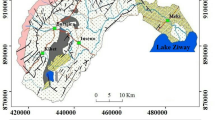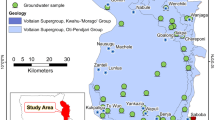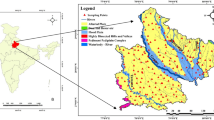Abstract
Hydrogeochemistry and groundwater quality of the Kadava River Basin have been performed by analyzing 40 groundwater samples for pre- and post-monsoon seasons of 2011 through different geostatistical techniques. Analyses showed that the concentrations of Mg2+ exceeded Ca2+ in both the seasons suggesting silicate weathering as a source of ions. Average Ca + Mg values contribute 73.53% of total cations and signify the major supply of mafic minerals. Elevated TDS and TH limit drinking potential and other beneficial uses indicate permanently hard water. The average concentrations of the anions were found within Indian PL except NO3, attributed to use of fertilizers. The spatial distribution maps show the EC, Mg, Na, Cl, and SO4 to be generally higher for both the seasons in flood plain deposits than denuded landforms and middle-level/high-level plateaus containing fractured basalt aquifers. It is confirmed that silicate weathering is the dominant process followed by carbonate weathering. Inputs of TDS, Cl, SO4, Mg, Na, and NO3 are influenced by rainfall and human activities. Groundwater sample numbers 20, 37, and 38 have been severely impacted from agricultural runoff as these samples are located along the surface water flow path. The high loading of TDS and TH is controlled by the Mg, Na, Cl, and SO4 ions. Elevated concentration of Na over Ca represents the ion exchange between Ca and Na. High contents of Mg, Na, Cl, and SO4 corroborate that the groundwater is influenced by anthropogenic sources. This study is an insight for water managers to address groundwater pollution problems.































Similar content being viewed by others
References
APHA A (2005) WPCF, standard methods for the examination of water and wastewater. American Public Health Association/American Water Works Association/Water Environment Federation, Washington DC
Barbieri M, Sappa G, Vitale S, Parisse B, Battistel M (2014) Soil control of trace metals concentrations in landfills: a case study of the largest landfill in Europe, Malagrotta, Rome. J Geochem Explor 143:146–154
Barbieri M, Nigro A, Petitta M (2017) Groundwater mixing in the discharge area of san Vittorino plain (Central Italy): geochemical characterization and implication for drinking uses. Environ Earth Sci 76(11):393
Beane JE, Turner CA, Hooper PR, Subbarao KV, Walsh JN (1986) Stratigraphy, composition and form of the Deccan basalts, Western Ghats, India. Bull Volcanol 48(1):61–83
Berner EK, Berner RA (1987) Global water cycle: geochemistry and environment. Prentice-Hall, Upper Saddle River
Bhardwaj V, Singh DS, Singh AK (2010) Water quality of the Chhoti Gandak River using principal component analysis, ganga plain, India. J Earth Syst Sci 119(1):117–127
BIS (2012) Indian standards specification for drinking water, BIS: 10500: 2012. http://www.cgwb.gov.in/ Documents/WQ-standards.pdf
Box GE (1978) Statistics for experimenters: an introduction to desing, data analysis, and model building. Probability and mathematical statistics
Cerling TE, Pederson BL, Von Damm KL (1989) Sodium-calcium ion exchange in the weathering of shales: implications for global weathering budgets. Geology 17(6):552–554
CGWB (2006) Central ground water board. Dynamic ground water resources of India –As on March 2004:1–120
CGWB (2014) Central Groundwater Board. http://cgwb.gov.in/district_profile/maharashtra/nashik.pdf
Chapman D (Ed) (1996) On the behalf of UNESCO, WHO. UXEP. Water quality assessments-a guide to use biota, sediments and water in environmental monitoring. F & F Spoil, London, Chapter 9
Danielsson Å, Cato I, Carman R, Rahm L (1999) Spatial clustering of metals in the sediments of the Skagerrak/Kattegat. Appl Geochem 14(6):689–706
Datta PS, Tyagi SK (1996) Major ion chemistry of groundwater in Delhi area: chemical weathering processes and groundwater flow regime. J Geol Soc India 47:179–188
Davies SN, DeWiest RJ (1966) Hydrogeology. Wiley, New York, pp 1–463
Dessai AG, Warrier S (1987) Mineralogy and geochemistry of the calcretes in alluvial sediments from Pune, India. J Geol Soc India 29(6):584–593
Devic G, Djordjevic D, Sakan S (2014) Natural and anthropogenic factors affecting the groundwater quality in Serbia. Sci Total Environ 468:933–942
Drever JI (1988) The geochemistry of natural waters. Prentice hall, Englewood cliffs, NJ. The geochemistry of natural waters, 2nd edn. Prentice Hall, Englewood Cliffs, NJ
Edmond JM, Palmer MR, Grant B, Stallard RF (1995) The fluvial geochemistry and denudation rate of the Guayana shield in Venezuela, Colombia, and Brazil. Geochim Cosmochim Acta 59(16):3301–3325
Fisher RS, Mullican WF III (1997) Hydrochemical evolution of sodium-sulfate and sodium-chloride groundwater beneath the northern Chihuahuan Desert, trans-Pecos, Texas, USA. Hydrogeol J 5(2):4–16
Frate C (2007) Nitrogen transformation in soil University of California Cooperative Extension, Tulare County http://cdrf.org/wp-content/uploads/2012/01/11.7_Nitrogen_Transformations-final.pdf. Accessed 15 Sept 2014
Gaillardet J, Dupré B, Louvat P, Allegre CJ (1999) Global silicate weathering and CO2 consumption rates deduced from the chemistry of large rivers. Chem Geol 159(1–4):3–30
Garrels RM and Christ CL (1967) Equilibres des minéraux et de leurs solutions aqueuses. Gauthier-Villars
Geological Survey of India (GSI) (2001) District resource map. GSI, Nashik District
Gibbs RJ (1970) Mechanisms controlling world water chemistry. Science 170(3962):1088–1090
Hem JD (1985). Study and interpretation of the chemical characteristics of natural water (Vol. 2254). Department of the Interior, US Geological Survey
Hounslow A (2018) Water quality data: analysis and interpretation. CRC press, Boca Raton
Houzim V, Vavra J, Fuska J, Pekny V, Vrba J, Stibral J (1986) Impact of Fertilizers and Pesticides on Groundwater Quality. In: Gastany G, Groba E, Rominj (eds) Impact of Agricultural Activities on Groundwater. IAH Publ., Hannover 332 p
Islam ARMT, Ahmed N, Bodrud-Doza M, Chu R (2017) Characterizing groundwater quality ranks for drinking purposes in Sylhet district, Bangladesh, using entropy method, spatial autocorrelation index, and geostatistics. Environ Sci Pollut Res 24(34):26350–26374
Jankowski J, Acworth RI and Shekarforoush S (1998) Reverse ion exchange in a deeply weathered porphyritic dacite fractured aquifer system, Yass. In New South Wales Australia. In: GB Arehart, JR Hulston (eds) Proceedings of 9th international symposium on water–rock interaction, Taupo, New Zealand, Vol 30, pp 243–246
Kale SS, Pawar N (2012) Origin of salinity in the groundwater of semi-arid Karha Basin, Maharashtra. Memoir Geol Soc India 80:145–166
Karanth KR (1987) Ground water assessment: development and management. Tata McGraw-Hill Education, New York City
Karroum M, Elgettafi M, Elmandour A, Wilske C, Himi M, Casas A (2017) Geochemical processes controlling groundwater quality under semi arid environment: a case study in Central Morocco. Sci Total Environ 609:1140–1151
Kortatsi BK (2006) Hydrochemical characterization of groundwater in the Accra plains of Ghana. Environ Geol 50(3):299–311
Kortatsi BK (2007) Hydrochemical framework of groundwater in the Ankobra Basin, Ghana. Aquat Geochem 13(1):41–74
Krishnan MS (1982) Geology of India and Burma, 6th edn. CBS publisher and distributors, New Delhi
Krumbein WC, Graybill FA (1965) An introduction to statistical models in geology. McGraw-Hill, New York City
Kumar R, Singh RD, Sharma KD (2005) Water resources of India. Curr Sci:794–811
Lattin JM, Carroll JD, Green PE (2003) Analyzing multivariate data. Thomson Brooks/Cole, Pacific Grove, CA
Loizidou M, Kapetanios EG (1993) Effect of leachate from landfills on underground water quality. Sci Total Environ 128(1):69–81
Mahato MK, Singh PK, Tiwari AK, Singh AK (2016) Risk assessment due to intake of metals in groundwater of east Bokaro coalfield, Jharkhand, India. Exposure and Health 8(2):265–275
Mertler CA and Vannatta RA (2005) Advanced and multivariate statistical methods. Glendale
Morrison G, Fatoki OS, Persson L, Ekberg A (2001) Assessment of the impact of point source pollution from the Keiskammahoek sewage treatment plant on the Keiskamma River-pH, electrical conductivity, oxygen-demanding substance (COD) and nutrients. Water SA 27(4):475–480
Mukate SV, Panaskar DB, Wagh VM, Pawar RS (2015) Assessment of groundwater quality for drinking and irrigation purpose: a case study of Chincholikati MIDC area, Solapur (MS), India. SRTMUs J Sci 4(1):58–69
Mukate S, Panaskar D, Wagh V, Muley A, Jangam C, Pawar R (2017) Impact of anthropogenic inputs on water quality in Chincholi industrial area of Solapur, Maharashtra, India. Groundw Sustain Dev:359–371. https://doi.org/10.1016/j.gsd.2017.11.001
Naik PK, Tambe JA, Dehury BN, Tiwari AN (2008) Impact of urbanization on the groundwater regime in a fast growing city in Central India. Environ Monit Assess 146(1–3):339–373
Naik PK, Awasthi AK, Anand AVSS, Behera PN (2009) Hydrogeochemistry of the Koyna River basin, India. Environ Earth Sci 59(3):613–629
Panaskar DB, Wagh VM, Muley AA, Mukate SV, Pawar RS, Aamalawar ML (2016) Evaluating groundwater suitability for the domestic, irrigation, and industrial purposes in Nanded tehsil, Maharashtra, India, using GIS and statistics. Arab J Geosci 9(13):615
Pandith M, Kaplay RD, Potdar SS, Sangnor H, Rao AD (2017) Impact of urbanization coupled with drought situations on groundwater quality in shallow (basalt) and deeper (granite) aquifers with special reference to fluoride in Nanded-Waghala municipal corporation, Nanded District, Maharashtra (India). Environ Monit Assess 189(9):428
Pawar NJ, Kale VS (2006) Waterfall tufa deposits from the Deccan Basalt Province, India: implications for weathering of basalts in the semi-arid tropics. Z Geomorph NF 145:17–36
Pawar NJ, Nikumbh JD (1999) Trace element geochemistry of groundwater from Behedi basin, Nasik district, Maharashtra. J Geol Soc India 54:501–514
Pawar NJ, Pawar JB, Kumar S, Supekar A (2008) Geochemical eccentricity of ground water allied to weathering of basalts from the Deccan Volcanic Province, India: insinuation on CO 2 consumption. Aquat Geochem 14(1):41–71
Pawar RS, Panaskar DB, Wagh VM (2014) Characterization of groundwater using groundwater quality index of Solapur industrial belt, Maharashtra, India. Int J Res Eng Technol 2(4):31–36
Pearson K (1896) Mathematical contributions to the theory of evolution. III. Regression, heredity, and panmixia. Philosophical Transactions of the Royal Society of London Series A, Containing Papers Of A Mathematical Or Physical Character 187:253–318
Peng ZX, Mahoney J, Hooper P, Harris C, Beane J (1994) A role for lower continental crust in flood basalt genesis? Isotopic and incompatible element study of the lower six formations of the western Deccan traps. Geochim Cosmochim Acta 58(1):267–288
Piper, A.M., (1944). A graphic procedure in the geochemical interpretation of water-analyses Eos, Transactions. Am Geophys Union 25(6):914–928
Prasanth SS, Magesh NS, Jitheshlal KV, Chandrasekar N, Gangadhar K (2012) Evaluation of groundwater quality and its suitability for drinking and agricultural use in the coastal stretch of Alappuzha District, Kerala, India. Appl Water Sci 2(3):165–175
Rabemanana V, Violette S, De Marsily G, Robain H, Deffontaines B, Andrieux P, Bensimon M, Parriaux A (2005) Origin of the high variability of water mineral content in the bedrock aquifers of southern Madagascar. J Hydrol 310(1–4):143–156
Rajmohan N, Elango L (2004) Identification and evolution of hydrogeochemical processes in the groundwater environment in an area of the Palar and Cheyyar River basins, Southern India. Environ Geol 46(1):47–61
Raju NJ, Patel P, Reddy BSR, Suresh U, Reddy TVK (2016) Identifying source and evaluation of hydrogeochemical processes in the hard rock aquifer system: geostatistical analysis and geochemical modeling techniques. Environ Earth Sci 75(16):1157
Ramakrishnan M and Vaidyanadhan R (2008) Geology of India (Vol. 1). Geological society of India
Rao NS (2014) Spatial control of groundwater contamination, using principal component analysis. J Earth Syst Sci 123(4):715–728
Rao NS, Marghade D, Dinakar A, Chandana I, Sunitha B, Ravindra B, Balaji T (2017) Geochemical characteristics and controlling factors of chemical composition of groundwater in a part of Guntur district, Andhra Pradesh, India. Environ Earth Sci 76(21):747
Rezaei A, Hassani H (2018) Hydrogeochemistry study and groundwater quality assessment in the north of Isfahan, Iran. Environ Geochem Health 40(2):583–608
Saager R, Sinclair AJ (1974) Factor analysis of stream sediment geochemical data from the mount Nansen area, Yukon territory, Canada. Mineralium Deposita 9(3):243–252
Sami K (1992) Recharge mechanisms and geochemical processes in a semi-arid sedimentary basin, eastern cape, South Africa. J Hydrol 139(1–4):27–48
Sarin MM, Krishnaswami S, Dilli K, Somayajulu BLK, Moore WS (1989) Major ion chemistry of the ganga-Brahmaputra river system: weathering processes and fluxes to the bay of Bengal. Geochim Cosmochim Acta 53(5):997–1009
Sefie A, Aris AZ, Ramli MF, Narany TS, Shamsuddin MKN, Saadudin SB, Zali MA (2018) Hydrogeochemistry and groundwater quality assessment of the multilayered aquifer in Lower Kelantan Basin, Kelantan, Malaysia. Environ Earth Sci 77(397). https://doi.org/10.1007/s12665-018-7561-9
SERI (2009) State of Environment Report India (SERI). Ministry of Environment and Forests, Government of India, p 179
Singh AK, Mondal GC, Singh PK, Singh S, Singh TB, Tewary BK (2005) Hydrochemistry of reservoirs of Damodar River basin, India: weathering processes and water quality assessment. Environ Geol 48(8):1014–1028
Singh KP, Malik A, Mohan D, Singh VK, Sinha S (2006) Evaluation of groundwater quality in northern indo-Gangetic alluvium region. Environ Monit Assess 112(1–3):211–230
Spears DA (1986) Mineralogical control of the chemical evolution of groundwater. Solute processes. Wiley, Chichester, p 512
Stallard RF, Edmond JM (1983) Geochemistry of the Amazon: 2. The influence of geology and weathering environment on the dissolved load. J Geophys Res Oceans 88(C14):9671–9688
Tiwari AK, Singh AK (2014) Hydrogeochemical investigation and groundwater quality assessment of Pratapgarh district, Uttar Pradesh. J Geol Soc India 83(3):329–343
Todd DK (1980) Groundwater hydrology, 2nd edn. Wiley, New York
Tóth J (1999) Groundwater as a geologic agent: an overview of the causes, processes, and manifestations. Hydrogeol J 7(1):1–14
Varade AM, Yenkie R, Shende R, Kodate J (2014) Drinking water quality assessment studies for an urbanized part of the Nagpur District, Central India. J Environ Sci Eng 56(1):53–64
Vasant W, Dipak P, Aniket M, Ranjitsinh P, Shrikant M, Nitin D, Manesh A and Abhay V (2016) GIS and statistical approach to assess the groundwater quality of Nanded tehsil,(MS) India. In Proceedings of first international conference on information and communication Technology for Intelligent Systems: volume 1. Springer, Cham, pp 409–417
Wagh VM, Panaskar DB, Varade AM, Mukate SV, Gaikwad SK, Pawar RS, Muley AA, Aamalawar ML (2016a) Major ion chemistry and quality assessment of the groundwater resources of Nanded tehsil, a part of Southeast Deccan Volcanic Province, Maharashtra, India. Environ Earth Sci 75(21):1418
Wagh VM, Panaskar DB, Muley AA, Mukate SV, Lolage YP, Aamalawar ML (2016b) Prediction of groundwater suitability for irrigation using artificial neural network model: a case study of Nanded tehsil, Maharashtra, India. Modeling Earth Systems and Environment 2(4):196
Wagh, V.M., Panaskar, D.B. and Muley, A.A., (2017a). Estimation of nitrate concentration in groundwater of Kadava river basin-Nashik district, Maharashtra, India by using artificial neural network model. Model Earth Syst Environ 3(1):36
Wagh VM, Panaskar DB, Muley AA, Mukate SV (2017b) Groundwater suitability evaluation by CCME WQI model for Kadava River basin, Nashik, Maharashtra, India. Model Earth Syst Environ 3(2):557–565
Wagh V, Panaskar D, Muley A, Mukate S, Gaikwad S (2018a) Neural network modelling for nitrate concentration in groundwater of Kadava River basin, Nashik, Maharashtra, India. Groundw Sustain Dev 7:436–445. https://doi.org/10.1016/j.gsd.2017.12.012
Wagh VM, Panaskar DB, Mukate SV, Gaikwad SK, Muley AA, Varade AM (2018b) Health risk assessment of heavy metal contamination in groundwater of Kadava River basin, Nashik, India. Model Earth Syst Environ 4(3):969–980
World Health Organization (WHO) (2011) Guidelines for drinking water quality, library cataloguing-in-publication data, 4th ed. NLM classification: WA. World Health Organization, Geneva, p 675
Acknowledgements
The authors would like to express sincere gratitude to the Director, School of Earth Sciences, SRTM University, Nanded for providing necessary facilities to carry out the present research work. Also, authors are grateful to anonymous reviewers for their meticulous assessment and significant comments which are helpful to strengthen the manuscript quality.
Author information
Authors and Affiliations
Corresponding author
Rights and permissions
About this article
Cite this article
Wagh, V.M., Panaskar, D.B., Jacobs, J.A. et al. Influence of hydro-geochemical processes on groundwater quality through geostatistical techniques in Kadava River basin, Western India. Arab J Geosci 12, 7 (2019). https://doi.org/10.1007/s12517-018-4136-8
Received:
Accepted:
Published:
DOI: https://doi.org/10.1007/s12517-018-4136-8




